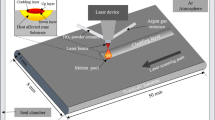Summary
Recent work in our laboratory on ion implanted single and poly crystalline metals and alloys has shown that ion implantation can have beneficial effects on the fatigue life of materials. For an exact determination of the influence of a particular implanted species, we have shown that it is necessary to characterize the defect structure, deformation modes, and surface residual stresses produced. These studies have shown that the fatigue crack initiation and lifetime could be extended by choosing an ion species which leads to more homogeneous deformation near the surface region. On the other hand, implantation into some alloy systems extends the fatigue life by forming second phases or producing compressive residual stresses. This paper will give an overview of the various effects that ion implantation can have on microstructure, deformation behavior, and fatigue crack initiation resistance. The base materials that have been examined include aluminum, copper, 4140 steel, and two titanium alloys.
Similar content being viewed by others
References
J. M. Poate and A. G. Cullis, “Implantation Metallurgy — Metastable Alloy Formation,” in Treatise on Materials Science and Technology, edited by J. K. Hirvonen, Academic Press, Vol. 13 (1980), pp. 85–133.
S. M. Myers, “Implantation Metallurgy — Equilibrium Alloys,” in Treatise on Materials Science and Technology, edited by J. K. Hirvonen, Academic Press, Vol. 13 (1980), pp. 51–83.
N. E. W. Hartley, “Tribological and Mechanical Properties,” in Treatise on Materials Science and Technology, edited by J. K. Hirvonen, Academic Press, Vol. 13 (1980), pp. 321–371.
H. Herman, “Surface Mechanical Properties — Effects of Ion Implantation,” Nucl. Inst. Mech., 182/183 (1981), pp. 887–898.
S. B. Chakrabortty, A. Kujore, and E. A. Starke, Jr., “The Effect of Ion Implantation on Cyclic Stress-Strain Response of Polycrystalline Copper,” Thin Solid Films, 73 (1980), pp. 209–219.
A. Kujore, S. B. Chakrabortty, E. A. Starke, Jr., and K. O. Legg, “The Effect of Ion Implantation on the Fatigue Properties of Polycrystalline Copper,” Nucl. Inst. Meth. 182/183 (1981), pp. 949–958.
W. W. Hu, C. R. Clayton, H. Herman, and J. K. Hirvonen, “Fatigue Life Enhancement by Ion Implantation,” Scr. Met., 12 (1978), pp. 697–698.
J. K. Hirvonen, C. A. Carosella, R. A. Kant, I. Singer, R. Vardiman, and B. B. Rath, “Improvement of Metal Properties by Ion Implantation,” Thin Solid Films, 63 (1979), pp. 5–10.
P. Heydari, E. A. Starke, Jr., S. B. Chakrabortty and K. O. Legg, “The Effect of Ion Implantation on Low Cycle Fatigue Behavior of Copper Single Crystals,” Ion Implantation into Metals, edited by V. Ashworth, W. A. Grant, and R. P. M. Procter, Pergamon Press (1981), pp. 172–179.
K. V. Jata and E. A. Starke, Jr., “Effect of Ion Implantation on Fatigue Properties,” in Proceedings of Surtech and Surface Coating Exposition, Dearborn, Michigan (1982).
K. V. Jata, J. Han, E. A. Starke, Jr., and K. O. Legg, “Ion Implantation Effect on Fatigue Crack Initiation in Ti-24V,” Scr. Met., 17 (1983), pp. 479–483.
I. W. Hall, “The Effect of Ion Implantation on the High Temperature Deformation of Molybdenum,” Met. Trans. 12A (1981), pp. 2093–2099.
S. B. Chakrabortty, A. Kujore, E. A. Starke, Jr., and K. O. Legg, “The Effect of Ion Implantation on the Fatigue Behavior of Metals and Alloys,” Sixth Conference on the Applications of Accelerators in Research and Industry, Denton, Texas (1980).
P. A. Theckery and R. S. Nelson, “The Formation of Precipitate Phases in Aluminum by Ion Implantation,” Phil. Mag., 19 (1969), pp. 169–180.
F. L. Vogel, Jr., “Implantation of Carbon into Thin Films,” Thin Solid Films, 27 (1975), pp. 369–376.
J. M. Poate, J. A. Borders, A. G. Cullis, and J. K. Hirvonen, “Ion Implantation as an Ultra Fast Quenching Technique for Metastable Alloy Production: The Ag-Cu System,” Appl. Phys. Lett., 30 (1977), pp. 365–367.
S. P. Singhal, H. Herman, and J. K. Hirvonen, “Spinodal Decomposition in Amorphous Au-Implanted Pt,” Appl. Phys. Lett., 32 (1978), pp. 25–26.
G. Longworth and N. E. W. Hartley, “Mössbauer Effect Study of Nitrogen-Implanted Iron Foils,” Thin Solid Films, 48 (1978), pp. 95–104.
S. B. Chakrabortty, S. Spooner, and E. A. Starke, Jr., “The Effect of Ion Plating and Ion Implantation on the Cyclic Response and Fatigue Crack Initiation in Metals and Alloys,” Technical Report 79-2, Office of Naval Research, April 1980.
S. Spooner and K. O. Legg, “X-Ray Diffraction Characterizations of Aluminum Ion Implanted Copper Crystals,” Ion Implantation Metallurgy, edited by C. M. Preece and J. K. Hirvonen, TMS-AIME, Warrendale, Pennsylvania (1980), p. 162.
Rights and permissions
About this article
Cite this article
Jata, K.V., Starke, E.A. Surface Modification by Ion Implantation—Effects on Fatigue. JOM 35, 23–27 (1983). https://doi.org/10.1007/BF03338342
Published:
Issue Date:
DOI: https://doi.org/10.1007/BF03338342




